Modeling and Evaluation of SiC Inverters for EV Applications
Abstract
:1. Introduction
1.1. Background
1.2. State-of-the-Art Analysis
1.3. Challenges
1.4. Structure of the Paper
2. Inverter Modeling
2.1. Introduction of ScanTool
2.2. Model Validation
2.2.1. SiC Power Module Characterization
2.2.2. Comparison of Inverter Efficiency Map
3. Vehicle-Level Modeling
Evaluation of Comprehensive Energy Consumption
4. Performance Evaluation
4.1. Endurance Mileage Improvement and Energy Consumption Distribution
4.2. Impact of Load Profile on Endurance Mileage
4.3. Impact of Drag Coefficient on Endurance Mileage
4.4. Impact of Chip Paralleling Number on System Cost
5. Conclusions
Author Contributions
Funding
Institutional Review Board Statement
Informed Consent Statement
Data Availability Statement
Conflicts of Interest
References
- Millan, J.; Godignon, P.; Perpina, X.; Perez-Tomas, A.; Rebollo, J. A survey of wide bandgap power semiconductor devices. IEEE Trans. Power Electron. 2013, 29, 2155–2163. [Google Scholar] [CrossRef]
- Zeng, Z.; Zhang, X.; Blaabjerg, F.; Chen, H.; Sun, T. Stepwise design methodology and heterogeneous integration routine of air-cooled SiC inverter for electric vehicle. IEEE Trans. Power Electron. 2019, 35, 3973–3988. [Google Scholar] [CrossRef]
- Jahdi, S.; Alatise, O.; Fisher, C.; Ran, L.; Mawby, P. An evaluation of silicon carbide unipolar technologies for electric vehicle drive-trains. IEEE J. Emerg. Sel. Top. Power Electron. 2014, 2, 517–528. [Google Scholar] [CrossRef]
- Ahmed, M.H.; Wang, M.; Hassan, M.A.S.; Ullah, I. Power loss model and efficiency analysis of three-phase inverter based on SiC mosfets for PV applications. IEEE Access 2019, 7, 75768–75781. [Google Scholar] [CrossRef]
- Li, Z.; Wang, J.; Ji, B.; Shen, Z.J. Power loss model and device sizing optimization of Si/SiC hybrid switches. IEEE Trans. Power Electron. 2020, 35, 8512–8523. [Google Scholar] [CrossRef]
- Sun, Y.; Yue, H.; Zhang, J.; Booth, C. Minimization of residential energy cost considering energy storage system and ev with driving usage probabilities. IEEE Trans. Sustain. Energy 2018, 10, 1752–1763. [Google Scholar] [CrossRef]
- Yamaguchi, K. Design and evaluation of SiC-based high power density inverter, 70 kW/liter, 50 kW/kg. In Proceedings of the 2016 IEEE Applied Power Electronics Conference and Exposition (APEC), Long Beach, CA, USA, 20–24 March 2016; pp. 3075–3079. [Google Scholar]
- Hirao, T.; Onishi, M.; Yasuda, Y.; Namba, A.; Nakatsu, K. EV traction inverter employing double-sided direct-cooling technology with SiC power device. In Proceedings of the 2018 International Power Electronics Conference (IPEC-Niigata 2018-ECCE Asia), Niigata, Japan, 20–24 May 2018; pp. 2082–2085. [Google Scholar] [CrossRef]
- Nisch, A.; Kloeffer, C.; Weigold, J.; Wondrak, W.; Schweikert, C.; Beaurenaut, L. Effects of a SiC tmosfet tractions inverters on the electric vehicle drivetrain. In Proceedings of the PCIM Europem, Nuremberg, Germany, 5–7 June 2018; pp. 1–8. [Google Scholar]
- Zhang, H.; Tolbert, L.M.; Ozpineci, B. Impact of SiC devices on hybrid electric and plug-in hybrid electric vehicles. IEEE Trans. Ind. Appl. 2011, 47, 912–921. [Google Scholar] [CrossRef]
- Su, M.; Chen, C.; Sharma, S.; Kikuchi, J. Performance and cost considerations for SiC-based HEV traction inverter systems. In Proceedings of the 2015 IEEE 3rd Workshop on WiPDA, Blacksburg, VA, USA, 2–4 November 2015; pp. 347–350. [Google Scholar]
- Wu, R.; Gonzalez, J.O.; Davletzhanova, Z.; Mawby, P.A.; Alatise, O. The potential of SiC cascode JFETs in electric vehicle traction inverters. IEEE Trans. Transp. Electrif. 2019, 5, 1349–1359. [Google Scholar] [CrossRef]
- Zhu, J.; Kim, H.; Chen, H.; Erickson, R.; Maksimovic, D. High efficiency SiC traction inverter for electric vehicle applications. In Proceedings of the 2018 IEEE Applied Power Electronics Conference and Exposition (APEC), San Antonio, TX, USA, 4–8 March 2018; pp. 1428–1433. [Google Scholar] [CrossRef]
- Brooker, A.; Gonder, J.; Wang, L.; Wood, E.; Lopp, S.; Ramroth, L. FASTSim: A model to estimate vehicle efficiency, cost and performance. SAE Tech. Pap. 2015, 1, 0973. [Google Scholar] [CrossRef]
- Wipke, K.; Cuddy, M.; Burch, S. ADVISOR 2.1: A user-friendly advanced powertrain simulation using a combined backward/forward approach. IEEE Trans. Veh. Technol. 1999, 48, 1751–1761. [Google Scholar] [CrossRef]
- Pou, J.; Osorno, D.; Zaragoza, J.; Jaen, C.; Ceballos, S. Power losses calculation methodology to evaluate inverter efficiency in electrical vehicles. In Proceedings of the 2011 7th International Conference-Workshop Compatibility and Power Electronics (CPE 2011), Tallinn, Estonia, 1–3 June 2011; pp. 404–409. [Google Scholar] [CrossRef]
- Qi, J.; Yang, X.; Li, X.; Tian, K.; Mao, Z.; Yang, S.; Song, W. Temperature dependence of dynamic performance characterization of 1.2-kV SiC power mosfets compared with Si IGBTs for wide temperature applications. IEEE Trans. Power Electron. 2019, 34, 9105–9117. [Google Scholar] [CrossRef]
- Sreedhar, V. Plug-in hybrid electric vehicles with full performance. In Proceedings of the 2006 IEEE Conference on Electric and Hybrid Vehicles, Pune, India, 18–20 December 2006; pp. 1–2. [Google Scholar] [CrossRef]
- Shen, J. Modeling Methodologies for Analysis and Synthesis of Controls and Modulation Schemes for High-Power Converters with Low Pulse Ratios; RWTH Aachen University: Aachen, Germany, 2013; Chapter 2; ISBN 978-3-942789-16-5. [Google Scholar]
- Liu, T.; Ning, R.; Wong, T.T.Y.; Shen, Z.J. Modeling and analysis of SiC MOSFET switching oscillations. IEEE J. Emerg. Sel. Top. Power Electron. 2016, 4, 747–756. [Google Scholar] [CrossRef]
- Wang, W.; Dai, Z.; Bao, M.; Chen, J.; Huang, W.; Liu, Y. A research on the RDE and WLTC cycle emission characteristics of hybrid electric vehicle. In Proceedings of the 2021 IEEE 4th International Conference on Electronics Technology (ICET), Chengdu, China, 7–10 May 2021; pp. 574–579. [Google Scholar] [CrossRef]
- Waheed, A.; Buss, K. Modeling and validation of a three-dimensional thermoelectric model of a 50 Ah lithium-iron-phosphate battery cell at three different ambient temperatures in the new European driving cycle (NEDC). In Proceedings of the AmE 2016—Automotive Meets Electronics; 7th GMM-Symposium, Dortmund, Germany, 1–2 March 2016; pp. 1–6. [Google Scholar]
- Lutz, J.; Schlangenotto, H.; Scheuermann, U.; De Doncker, R. Semiconductor Power Devices—PhySiCs, Characteristics, Reliability; Springer: Berlin/Heidelberg, Germany, 2017; Volume 9, pp. 342–390. ISBN 978-3-642-11125-9. [Google Scholar]
- Yamaguchi, K.; Katsura, K.; Yamada, T.; Sato, Y. Criteria for using antiparallel SiC SBDs with SiC mosfets for SiC-based inverters. IEEE Trans. Power Electron. 2019, 35, 619–629. [Google Scholar] [CrossRef]
- Krishna Moorthy, R.S.; Aberg, B.; Olimmah, M.; Yang, L.; Rahman, D.; Lemmon, A.N.; Yu, W.; Husain, I. Estimation, Minimization, and Validation of Commutation Loop Inductance for a 135-kW SiC EV Traction Inverter. IEEE J. Emerg. Sel. Top. Power Electron. 2020, 8, 286–297. [Google Scholar] [CrossRef]



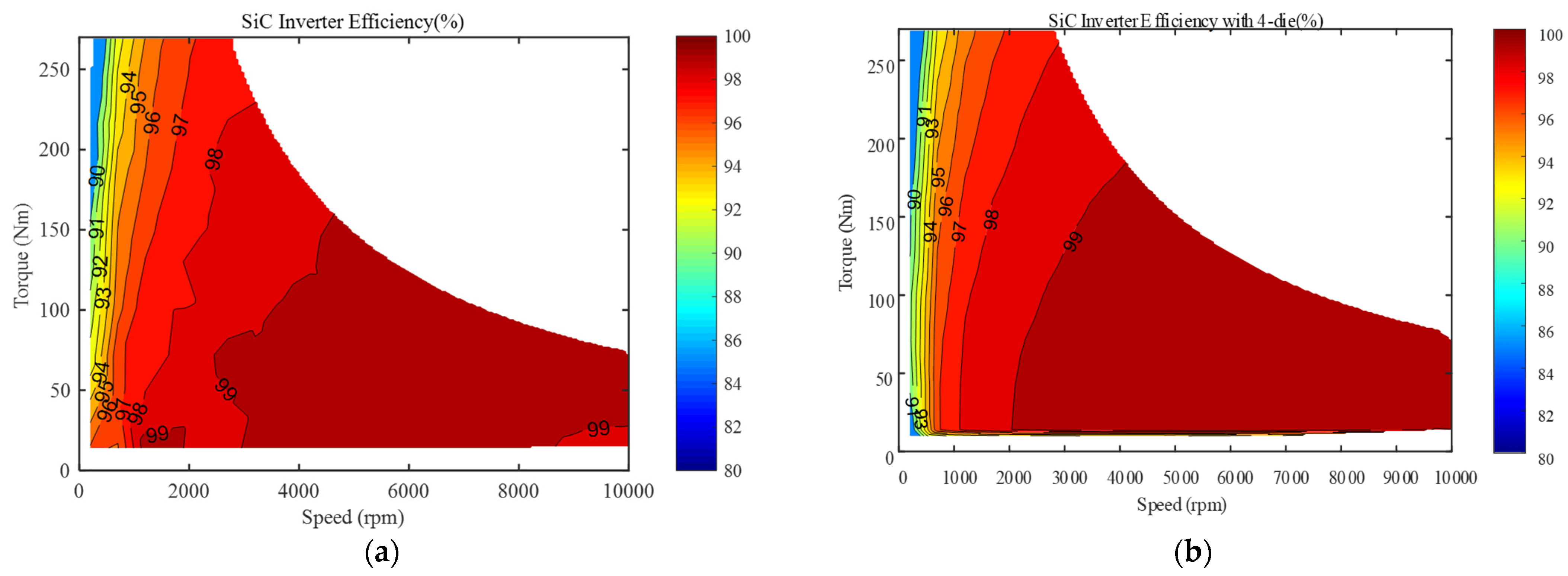
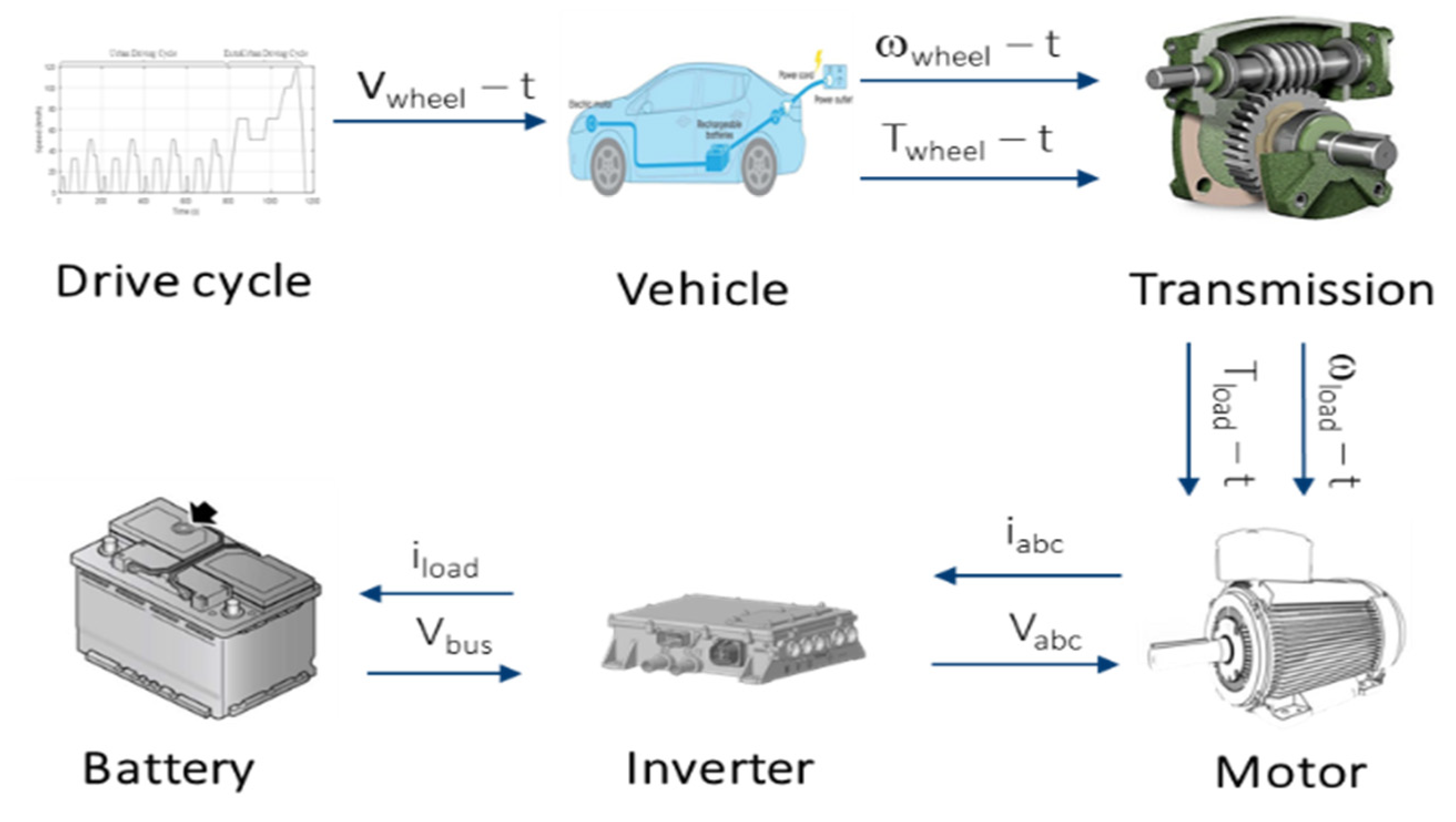
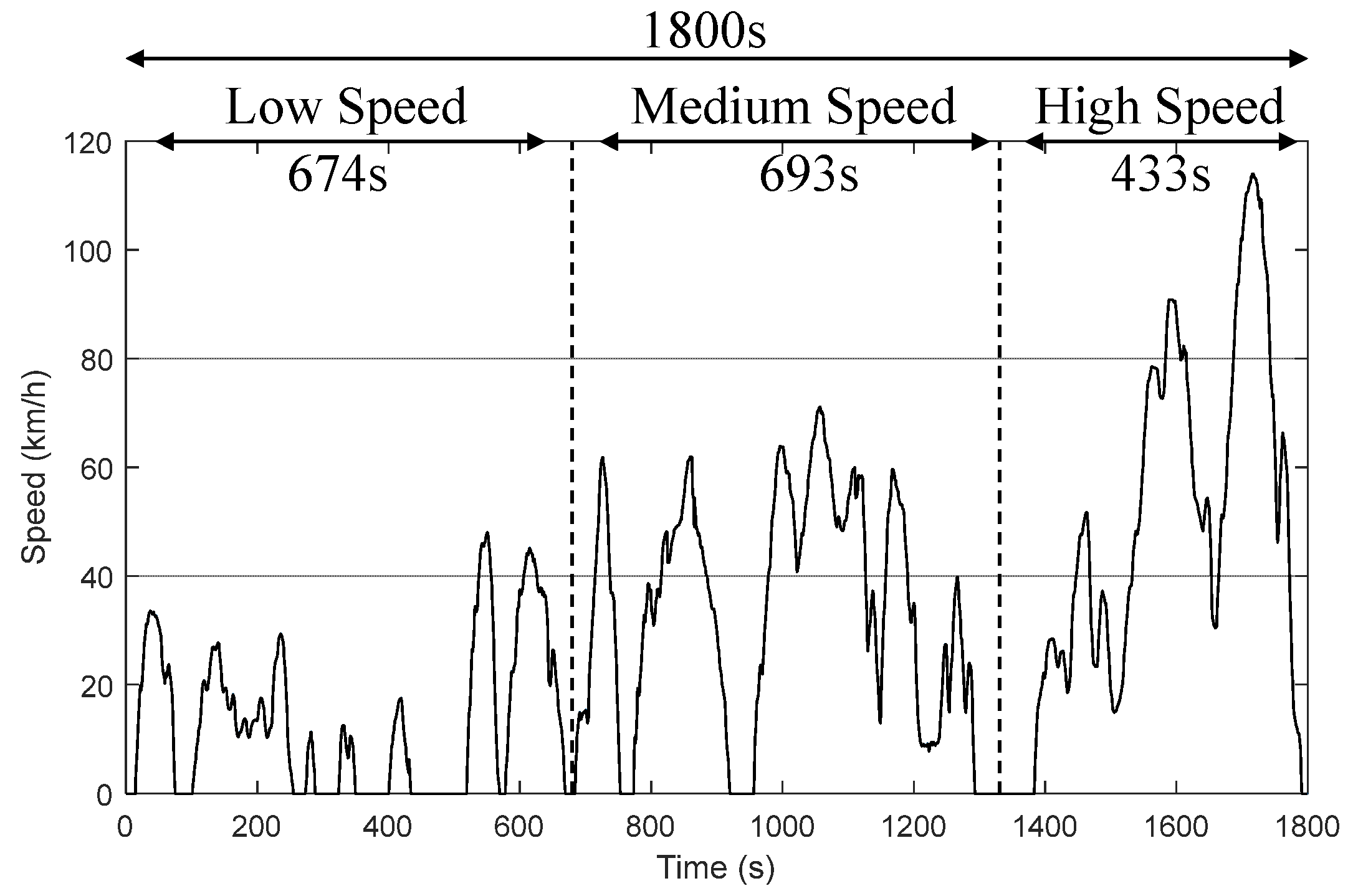
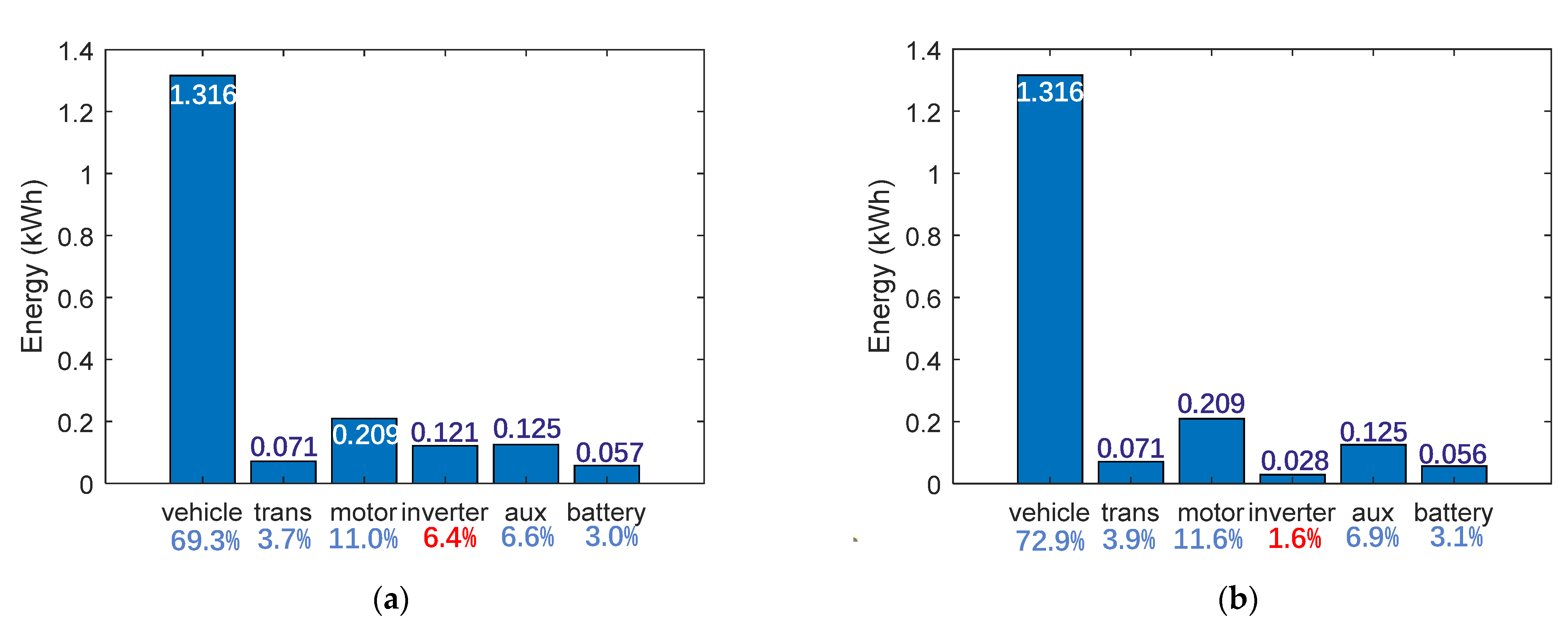
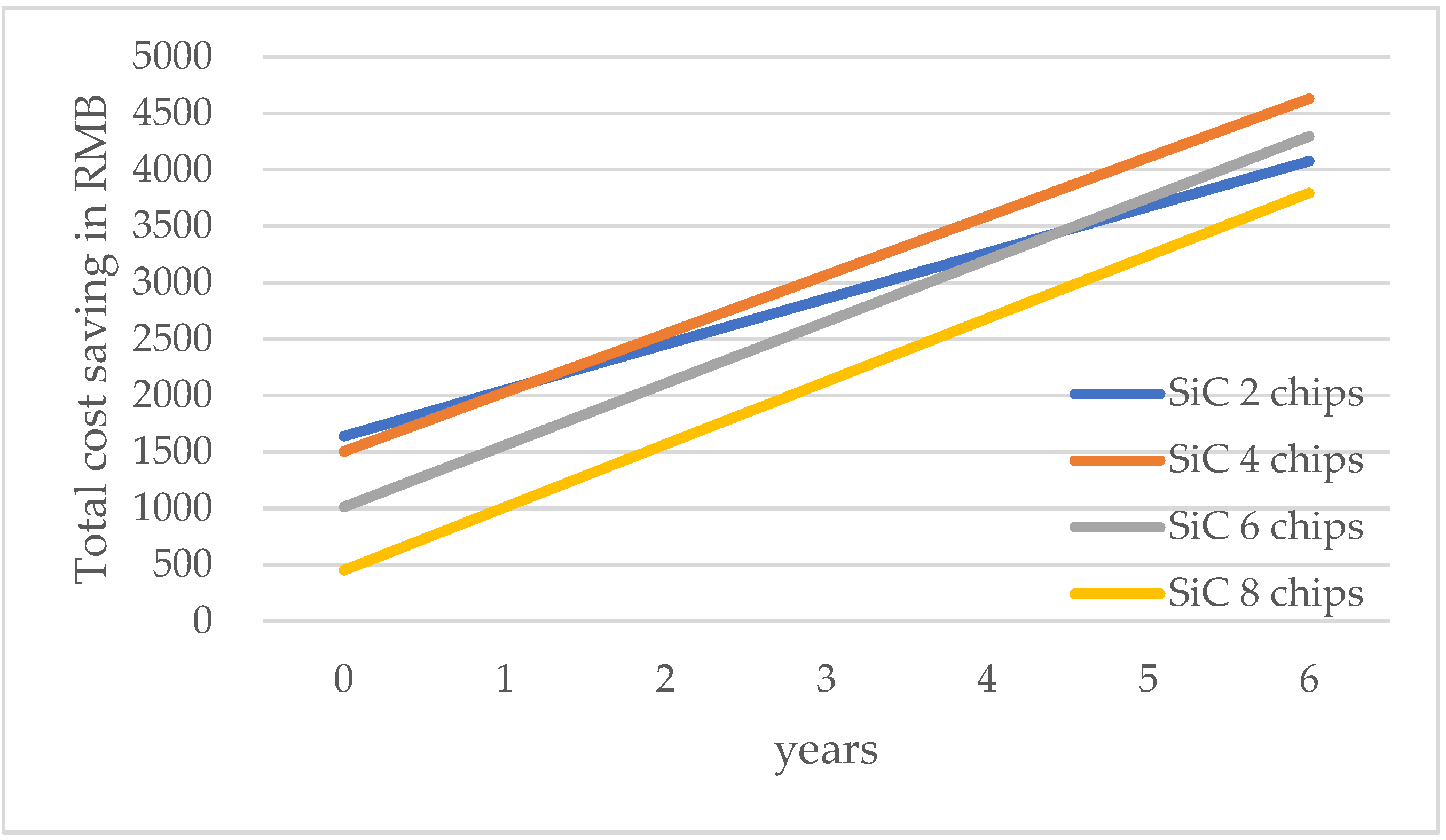
| Setup | Value |
|---|---|
| DC-link voltage | 420 V |
| Carrier frequency | 10 kHz |
| Modulation scheme | SVPWM |
| Motor type | PMSM |
| Power analyzer | WT300E |
| Efficiency | Measured | Simulated | Error |
|---|---|---|---|
| Max. | 99.07% | 98.78% | 0.29% |
| Min. | 74.83% | 64.04% | 10.79% |
| η > 95% area | 73.75% | 76.75% | −3% |
| η > 90% area | 90.14% | 89.79% | 0.35% |
| Efficiency | Measured | Simulated | Error |
|---|---|---|---|
| Max. | 99.93% | 99.73% | 0.2% |
| Min. | 86.39% | 89.59% | −3.2% |
| η > 95% area | 90.76% | 90.84% | −0.08% |
| η > 90% area | 98.72% | 98.39% | −0.33% |
| Drag coefficient | 0.3 |
| Front total area | 2.832 |
| Mass of the vehicle | 2270.2 kg |
| Max power of motor | 285 kW |
| Inertia of wheel | 0.815 Kg·m2 |
| Num of wheels | 4 |
| Radius of wheel | 0.336 m |
| Friction coefficient of wheel | 0.7 |
| Efficiency of charger | 0.86 |
| Power of aux devices | 0.25 kW |
| Efficiency of transmission | 0.98 |
| Load Profile | Energy Consumption per 100 km | Endurance Mileage Increase |
|---|---|---|
| CLTC-P | 12.47 kWh (Reduced by 4.95%) | 23.84 km (60 kWh Battery) |
| WLTC | 15.63 kWh (Reduced by 3.46%) | 13.28 km (60 kWh Battery) |
| Drag Coefficient | Energy Consumption per 100 km | Endurance Mileage Increase |
|---|---|---|
| 0.3 | 12.47 kWh (Reduced by 4.95%) | 23.84 km (60 kWh Battery) |
| 0.33 | 12.87 kWh (Reduced by 4.79%) | 22.22 km (60 kWh Battery) |
| Items | Assumptions |
|---|---|
| Battery | Ternary lithium battery with 780 RMB/kWh. |
| IGBT module | A three-phase half-bridge power module with 1200 RMB |
| SiC module | 2200 RMB using 4-chip version and 2800 RMB using 6-chip version; The cost increases linearly with chip number |
| Charging | 2 RMB/kWh |
| Operation time | The vehicle runs 220 days a year, with an average of 8 h per day. |
| Load profile | CLTC |
| Battery level | The range of the vehicle is more than 500 km, and the battery power is about 80 kWh. The initial investment of the battery is evaluated based on the same endurance mileage, so the battery power of different chip schemes changes slightly. Ignore the reduction of vehicle weight caused by less battery due to the improvement of efficiency. |
Publisher’s Note: MDPI stays neutral with regard to jurisdictional claims in published maps and institutional affiliations. |
© 2022 by the authors. Licensee MDPI, Basel, Switzerland. This article is an open access article distributed under the terms and conditions of the Creative Commons Attribution (CC BY) license (https://creativecommons.org/licenses/by/4.0/).
Share and Cite
Su, H.; Zhang, L.; Meng, D.; Li, Y.; Han, N.; Xia, Y. Modeling and Evaluation of SiC Inverters for EV Applications. Energies 2022, 15, 7025. https://doi.org/10.3390/en15197025
Su H, Zhang L, Meng D, Li Y, Han N, Xia Y. Modeling and Evaluation of SiC Inverters for EV Applications. Energies. 2022; 15(19):7025. https://doi.org/10.3390/en15197025
Chicago/Turabian StyleSu, Hui, Lijun Zhang, Dejian Meng, Yisu Li, Na Han, and Yuxin Xia. 2022. "Modeling and Evaluation of SiC Inverters for EV Applications" Energies 15, no. 19: 7025. https://doi.org/10.3390/en15197025
APA StyleSu, H., Zhang, L., Meng, D., Li, Y., Han, N., & Xia, Y. (2022). Modeling and Evaluation of SiC Inverters for EV Applications. Energies, 15(19), 7025. https://doi.org/10.3390/en15197025






